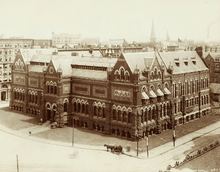John Hubbard Sturgis

John Hubbard Sturgis (August 5, 1834 - February 14, 1888)[1] was an American architect active in the Boston area.
Sturgis was born in Macau, China, the son of the "very intelligent" [2]Russell Sturgis,[1] a wealthy Boston merchant active in the China trade. After attending Boston Latin School, he travelled extensively in Europe when his father became a partner in Barings Bank in London. In England, he studied drawing under artist James K. Colling. In 1858, Sturgis married Frances Anne Codman[1] of Boston, later to be aunt of noted interior designer Ogden Codman, Jr. Their first three years were spent in Surrey, where Sturgis tried an architectural practice, but ended with the death of their first child, Julia, in January 1861.

In autumn 1861 Sturgis and his wife returned to Boston, where Sturgis found work at Bryant and Gilman, then the largest architectural firm in Boston. During this time he worked his own practice as well, providing designs for seaside cottages for members of the family and others. Beginning with Sunnywaters in Manchester-by-the-Sea, Massachusetts, for his older brother Russell in 1862, he also designed a home in Cotuit, Massachusetts, for the Charles Russell Codmans, and a seaside house, Land’s End, on Ledge Road, Newport, Rhode Island, for Sam Ward, his father's business associate. This house was later acquired by Edith Wharton, a cousin through the New York Newbolds, and completely reworked by her and Ogden Codman, Jr. for their book, The Decoration of Houses. In 1862 he also thoroughly redesigned the Codman House in Lincoln, Massachusetts for his wife's father.
In 1866, Sturgis formed a partnership with a fellow Bryant and Gilman employee, Charles Brigham, to found Sturgis and Brigham. This partnership would last twenty years, until shortly before Sturgis's death. In later years Sturgis redesigned the 1737 Boylston House in Brookline, which he rented between 1870 and 1888 from Colonel Henry Lee. He also designed notable houses for Isabella Stewart Gardner on Beacon Street; Frederick Ames at 306 Dartmouth Street in Boston's Back Bay (now known as the Ames-Webster Mansion); Edward N. Perkins on the shore of Jamaica Pond, known as Pinebank Mansion (1868) which served as the prototype for the terra cotta used in the Museum of Fine Arts; and "The Cottage" (1871) for H. H. Hunnewell on the Hunnewell estate in Wellesley, MA. This last commission is considered to be the first bona-fide example of the Queen Anne style of residential architecture in the United States.
Perhaps his most notable commissions were the first building for the Museum of Fine Arts (completed in 1876) in Copley Square, the ornamental detail for which was executed in imported English terra cotta, and the Church of the Advent on Beacon Hill, executed in the Early English Gothic Style between 1875 and 1888.
After his death, his nephew Richard Clipston Sturgis continued the architectural practice.
References
| Wikimedia Commons has media related to Sturgis & Brigham. |
- Boit, Robert Apthorp (2009). Chronicles of the Boit Family and Their Descendants and of Other Allied Families. Bibliobazaar. ISBN 978-1-113-65501-1.
|